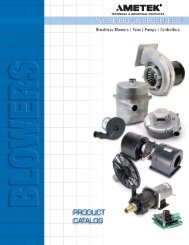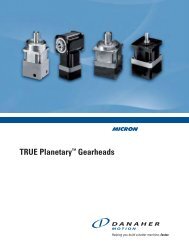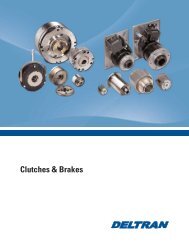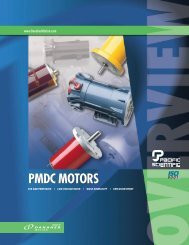Profile Rail Linear Guides
Profile Rail Linear Guides
Profile Rail Linear Guides
You also want an ePaper? Increase the reach of your titles
YUMPU automatically turns print PDFs into web optimized ePapers that Google loves.
<strong>Profile</strong> <strong>Rail</strong> <strong>Linear</strong> <strong>Guides</strong><br />
Preloading & <strong>Linear</strong> Guide Deflection<br />
Deflection Curves<br />
Preload<br />
A preloaded bearing has a condition of interference<br />
between the races of the rails, the rolling elements, and<br />
the races of the carriage.<br />
Preloading decreases the deflection due to external<br />
loads. This occurs because the contact reaction has<br />
already developed, eliminating much of the initial nonlinear<br />
deflection associated with rolling elements.<br />
The rolling element reactions within a preloaded bearing<br />
may be considered as having two components. One<br />
com ponent acts in the direction of external load, and<br />
one component acts in the opposing direction in order<br />
to maintain static equilibrium. These components are<br />
referred to as load sets. As external load is applied,<br />
one load set increases in load, as the opposite load<br />
set decreases in load. At some point, the load on the<br />
decreasing load set becomes zero. This point, at which<br />
the preload is relieved, is called the preload end point.<br />
Preload end typically occurs when the external load is<br />
approximately three times the preload.<br />
The following pages contain deflection charts for the<br />
500 Series <strong>Profile</strong> <strong>Rail</strong> <strong>Linear</strong> <strong>Guides</strong>. The charts shown<br />
are calculated. The calculation is based on theoretical<br />
conditions regarding shape, position and dimension of<br />
the balls and raceways of the carriage and rails under<br />
the specified loading. The real behavior of the carriage<br />
can vary slightly in the application as a result of base<br />
flatness, angle of loading, temperature, etc.<br />
Note that the deflection decreases as the preload or the<br />
bearing size increases.<br />
For deflection characteristics of linear guide types<br />
not shown, contact Danaher Motion Application<br />
Engineering at (540) 633-3490.<br />
Preload end point :<br />
F ext = 3F p<br />
where:<br />
F ext = externally applied load<br />
F p = preload<br />
By definition, a preloaded bearing, loaded beyond the preload<br />
endpoint, has the same deflection characteristics<br />
of an unpreloaded bearing externally loaded to that percentage<br />
of its dynamic load capacity. A preload level is<br />
assigned as a percentage of the dynamic load capacity<br />
of the bearing.<br />
Engineering<br />
Guide<br />
www.thomsonlinear.com 103











